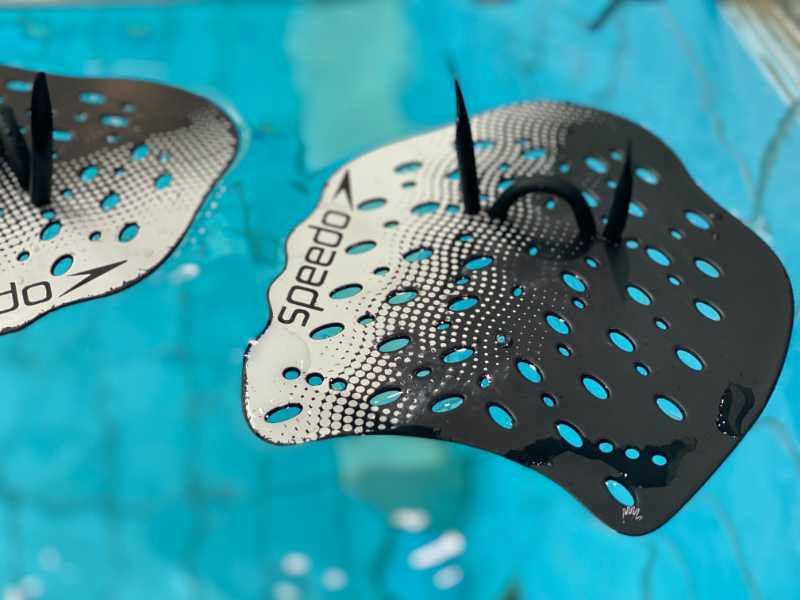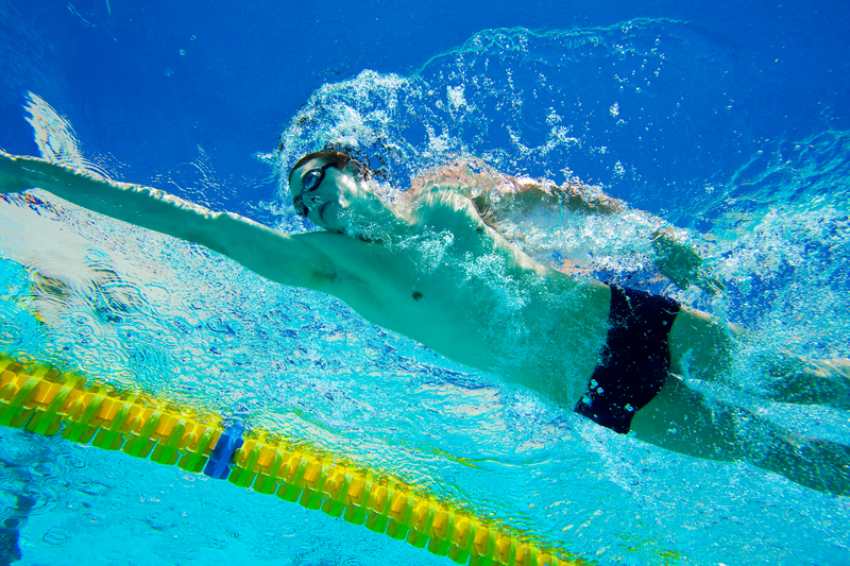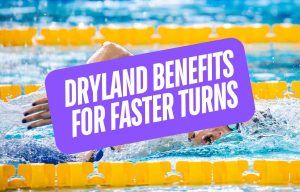Ready to level up your freestyle? Here’s how to improve and strengthen your freestyle pull and catch, and a couple of my favorite pull workouts.
The freestyle pulling motion is the major source of propulsion in the water.
When you are churning across your local pool, it’s your arms and shoulders that are doing the majority of the work.
A study with competitive swimmers found that even at sprint speeds, 70% of speed was generated by the pull1.
Other studies with swimmers at “normal” swim speeds had the pull providing up to 85-90% of the propulsion2.
In other words, the pull more than pulls its weight (swim pun!) when it comes to speed in the water.
If you feel like you aren’t getting enough from your pull, there are plenty of ways that you can improve your technique AND increase the amount of power you get from your pull.
In this article, we will look at how to level up your freestyle pull, including some key drills and a couple of swim workouts to get things going.
Let’s dive right in.
How to Improve & Strengthen the Freestyle Catch and Pull
1. Master the catch
Before we jump into getting a stronger pull, let’s break down the technical basics of a strong freestyle pull.
And this starts with the catch.
This is where your hand first “catches” water and starts pulling you across the pool.
You may have heard the term “early vertical forearm” when it comes to a better freestyle pull.
In essence, the sooner your forearm is vertical, the more water you are going to pull, and the faster you are going to go.
One of the common mistakes swimmers make is a hand during the catch phase that is largely horizontal.
When this happens, water is pushed down instead of back.
Freestyle drills to improve the catch include:
- Sculling. Sculling for swimmers is an excellent way to improve your feel for the water and target specific parts of the pulling motion. Extend your arms out in front of you, and move your hands back and forth, trying to catch lots of water at the top of the catch.
- Long dog drill. You’ve done dog paddle before, now try long dog! It’s like regular freestyle swimming but you recover the arms completely under the water. This drill gives you a chance to really nail the early vertical forearm at the top of your stroke.
With both of these drills, consider using a swimmer’s snorkel so that you can fully focus on the catch.
Another thing you can do outside of the water is to use some resistance tubing and mimicking the early vertical forearm you want.
Doing this on dry land will help you get used to the movement and also help increase the range of motion necessary to effectively catch water.
2. Improve pull strength with the right gear
Swimmers have no shortage of equipment when it comes to training aids.
When it comes to improving the freestyle pull, we’ve got some options:
- Pull-buoy. The pull buoy is a classic piece of swim equipment that isolates the pull and builds upper body strength. Made of EVA foam, it raises your hips in the water and forces you to rely solely on the pulling motion for propulsion.
- Paddles. Paddles increase the surface area of your hands, activating more muscle in the arms and shoulders. Swim paddles can be used on their own or with a pull-buoy, or even with increased resistance by pairing them with a swim parachute.

- Ankle strap. To get the most from your pull sets, consider using an ankle strap to eliminate any light kicking. Using an ankle strap will really emphasize the arm stroke, and it’s “heavy” on the shoulders so make sure to progress smartly to this level of resistance.
- Swim parachute. One of my favorite tools—and a decent substitute for power towers and resistance bands—swim parachutes allow you to swim with variable resistance without affecting stroke technique. (DragSox are also an excellent alternative to a swim parachute.)
There are lots of tools to throw at a stronger pull.
Mix up some longer, smoother pull sets that maximize technique with shorter, higher intensity pull-focused reps to build power.
3. Use stretch cords for increased activation before swim practice
Most swimmers own a pair of resistance tubes (also known as StretchCordz or stretch cords). They are an excellent dryland training tool for strengthening your pulling motion.
Researchers found that using StretchCordz in a very specific manner before a swim workout could significantly increase power output.
The swimmers did 2×5 pulls with their StretchCordz, and then eight minutes later, swam a 25m freestyle all-out.
Speed increased modestly by 3%, but the eye-raising improvements came in power output, which surged by 13-19%.
One of the essentials when it comes to dryland workouts for swimmers is specificity, and stretch cords are about as specific as you can get out of the water for a better freestyle pull.
4. Work on distance per stroke
Fast swimmers are efficient swimmers. When you watch the best of the best do it, whether we are talking about Michael Phelps, Caeleb Dressel, or Katie Ledecky, they make it look easy. They cross the pool extremely efficiently.
Working on your distance per stroke means that you swim faster with less strokes. How to
Count your strokes.
Counting your strokes is an excellent and HIGHLY recommended way of maintaining focus and concentration of efficiency when swimming.
Stroke counting is something I still do, years removed from competitive swimming.
Do Mini Maxi Reps.
Try swimming a 50m freestyle fast and count your stroke. Take the time, add the number of strokes you took, and you have a number to beat.
For example, if you swim a 50 freestyle in 30 seconds, and take 25 strokes, you have a number of 55. Next time you swim, aim for a score of 54 (time of :29 in 25 strokes, or time of :30 in 24 strokes).
Mini Maxi swimming—this is the exact same as SWOLF, if this concept sounds familiar—is an excellent way to maximize efficiency and distance per stroke in the water.
Note: With any kind of swim training that is heavily focused on your shoulders, whether that means using your pull buoy, paddles, and/or ankle strap, make sure to warm up your shoulders generously before jumping in and getting to work. Dynamic stretches like arm swings are a swimmer’s best friend for shoulder health!
Pull Workout #1: 2,500m Pull and Power Swim Workout
500 choice swim warm-up
8×100 freestyle with pull buoy (descend effort 1-4, twice) @1:30 (pick an interval where you get :15-:20 rest)
Extra minute rest
16×50 freestyle with pull buoy and paddles (descend effort 1-4, four times through) @1:00 (pick an interval where you get :20 or so rest)
Extra minute rest
8×25 freestyle with a pull buoy, paddles, and ankle strap. Fast! @:45
200 swim easy warm-down
Notes: I love doing descending volume sets like this where speed goes up as the reps get shorter over the course of the workout. Feel free to play around with volume and intervals as it corresponds to your ability and conditioning.
Pull Workout #2: 3,450 of Pure Pulling Power
500 choice swim and pull warm-up
5×200 freestyle with pull buoy and paddles @:30 rest (Smooth speed, focus on early vertical forearm and good body position in the water.)
10×25 freestyle ALL OUT with pull buoy and parachute @1:00
5×100 freestyle with pull buoy and paddles @:20 rest (Smooth speed, focus on early vertical forearm and good body position in the water.)
10×25 freestyle ALL OUT with pull buoy and parachute @1:00
10×50 freestyle with pull buoy and paddles @:20 rest (Smooth speed, focus on early vertical forearm and good body position in the water.)
10×25 freestyle ALL OUT with pull buoy and parachute @1:00
200 swim easy warm-down
Notes: The 200s, 100s, and 50s are all about smooth speed and excellent technique. On the 25s with pull buoy and parachute, hammer down and take plenty of rest to ensure high quality of effort on each rep.
The Final Lap
There is perhaps nothing more satisfying than improving in the water.
Being able to swim more efficiently and with more power and speed is kind of the best!
Use the drills, tips, and equipment listed above, try the pull workouts, and pull your way to faster swimming.
More Guides Like This
10 Freestyle Drills for a Faster Freestyle. Power up your freestyle with 10 freestyle drills from some of the best coaches and swimmers on the planet.
7 Tips for Improving Your Freestyle Stroke. Unlock a faster and more efficient freestyle stroke with this list of seven proven tips for killer freestyle technique.
6 Freestyle Swim Sets and Workouts. Get your freestyle on with this collection of my favorite freestyle sets and practices.














